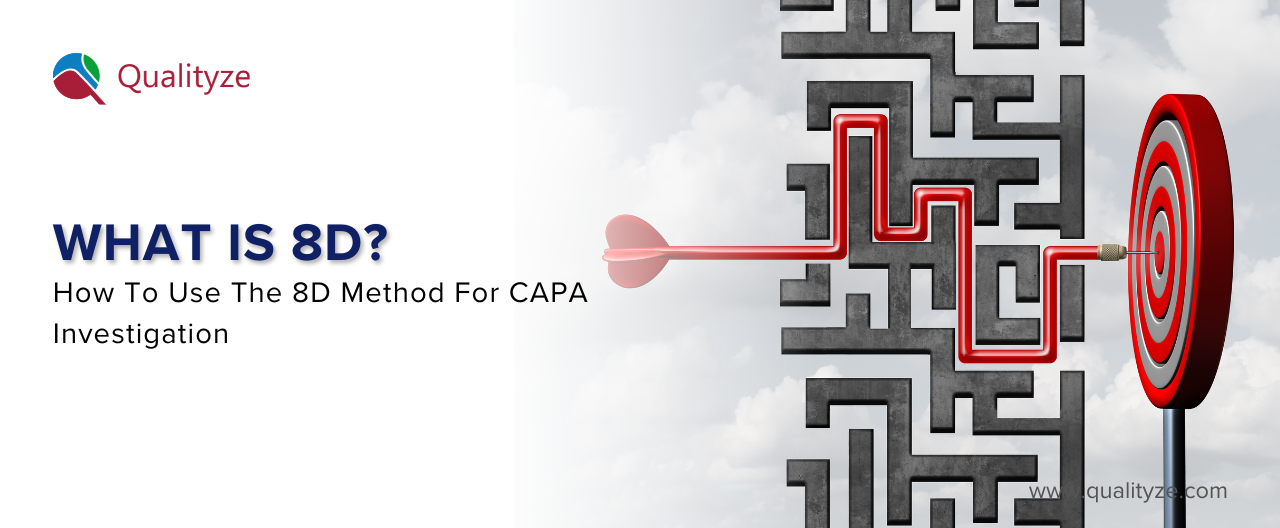Calculate your potential savings with our ROI Calculator
ROI CalculatorCalculate your potential savings with our ROI Calculator
ROI Calculator1 What is 8D and Why It Matters in Quality Investigations
2 What are the Eight Disciplines (8D)?
3 What is 8D in CAPA?
The Eight Disciplines (8D) Process Explained
5 How to Use the 8D Method for CAPA?
6 When to Use the 8D Method in CAPA Investigations
7 Mistakes to Avoid When Using 8D in CAPA Investigations
8 Integrating 8D Corrective Action with Quality Management Systems
9 The Role of EQMS in 8D Corrective Action
10 Automate 8D Workflows with Qualityze
11 Concluding thoughts for the blog:

Wondering what is 8D in CAPA investigations? Learn how this structured method helps uncover root causes, prevent recurrence, and ensure compliance.
The term “8D” might sound procedural at first glance, but within quality-intensive industries, it stands as a strategic necessity. The Eight Disciplines (8D) method represents a comprehensive, evidence-based framework for tackling recurring issues—going well beyond surface-level fixes to ensure problems are resolved at their core.
For sectors bound by rigorous standards—such as pharmaceuticals, automotive manufacturing, and medical devices—Corrective and Preventive Actions (CAPA) aren’t just operational tasks; they are compliance imperatives. However, organizations often face hurdles when it comes to identifying the true root cause, managing containment effectively, and sustaining improvements over time. That’s where the 8D methodology becomes indispensable. It aligns precisely with globally recognized frameworks like ISO 13485, FDA QSR, and IATF 16949.
In this blog, we’ll explore the principles behind the 8D method, its integration within CAPA system, potential pitfalls to avoid, and how Qualityze EQMS enables organizations to scale this process seamlessly for long-term success.
The Eight Disciplines—commonly known as 8D—form a structured, team-based methodology designed to identify, correct, and prevent recurrence of problems. Originally developed by the Ford Motor Company, the approach has since been adopted globally as a best practice in quality management.
Here are the Eight Disciplines:
Did You Know? The 8D method was first introduced as TOPS (Team-Oriented Problem Solving) by Ford in the 1980s.
While CAPA represents the overarching regulatory framework for addressing quality issues, 8D is the tactical engine that powers effective CAPA execution.
CAPA requires organizations to:
8D complements this by offering a roadmap for structured investigation:
In regulated environments, an 8D-based CAPA process ensures compliance with ISO 13485, FDA 21 CFR Part 820, and ISO 9001.
From the fact files! Over 70% of failed audits in FDA-regulated industries are linked to inadequate CAPA systems.
Let’s now break down each of the Eight Disciplines.
A closer look at the step-by-step process:
Next up, we explore how to align this process with your CAPA framework.
Integrating 8D into your CAPA process isn’t just smart—it’s strategic. Each discipline maps directly to critical CAPA stages, ensuring structure, traceability, and regulatory alignment.
Aligning your CAPA SOP with the 8D framework ensures consistency, reduces human error, and improves audit preparedness.
Transitioning to the next part of the blog, we understand When is 8D necessary in the operations?
Not every issue warrants an 8D. But for high-risk, recurring, or regulatory-triggered problems, it’s indispensable. Here is exactly when 8D adds the most value. Have a look at the list:
Choosing when to apply 8D in these scenarios ensures that problems are resolved at the root and not merely patched.
Next up, let’s understand the common errors that derail 8D efforts.
Even seasoned quality teams fall into common 8D traps that compromise investigations. Knowing what to avoid is as important as knowing what to do. Despite its strengths, misapplication of the 8D process can lead to ineffective CAPAs. Common pitfalls include:
Avoiding these ensures that your CAPA process stands up to regulatory scrutiny.
Let’s now look at how integrating 8D with your QMS strengthens outcomes overall.
To achieve consistent, audit-ready results, 8D must be embedded into your broader QMS. Embedding 8D in your Quality Management System ensures standardized practices and system-wide learning. How? Have a look at these:
When 8D becomes systemic, quality culture matures. Teams work proactively, not reactively.
Manual 8D execution is time-consuming and error-prone. An Enterprise Quality Management System (EQMS) digitizes and streamlines the process for greater accuracy and speed. EQMS systems like Qualityze simplify 8D execution by digitizing and automating every step:
A robust EQMS transforms 8D from a checklist into a dynamic workflow. EQMS tools ensure that CAPA investigations are faster, more reliable, and aligned with compliance frameworks.
Automation is key to consistency in quality. Brands like Qualityze equips you with configurable templates, digital RCA tools, and seamless tracking for every step of the 8D journey. Our EQMS empowers organizations to:
With mobile access, user roles, and integration capabilities, Qualityze turns 8D into a living, scalable process.
The 8D methodology represents more than compliance; it fosters a culture of ownership, continuous learning, and operational excellence. In today’s regulatory landscape, having a structured, auditable, and proactive CAPA system is non-negotiable.
Key takeaways from today’s topic:
Why Qualityze?
Qualityze EQMS Suite offers comprehensive 8D and CAPA capabilities that help ensure your quality team is not just responsive, but strategically proactive. From digital workflows to robust RCA tools, it aligns compliance with business improvement.
Request a Personalized DEMO
Discover how Qualityze can transform your CAPA investigations and embed 8D best practices into your quality system.
Request a DEMO today and take the next step toward smarter quality management.